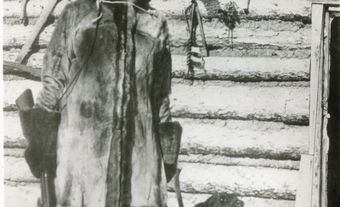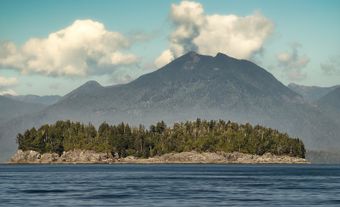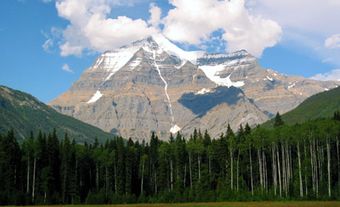Phyllis Beatrice Munday (née James), CM, mountaineer (born 24 September 1894 in Ceylon [now Sri Lanka]; died 11 April 1990 in Nanaimo, BC). Phyllis Munday was an avid mountaineer, summiting over 100 peaks in her lifetime. She was a pioneer for women in mountaineering and was the first woman to summit Mount Robson, the highest peak in the Canadian Rocky Mountains, among other peaks. She and her husband, Don Munday, surveyed parts of British Columbia’s Coast Mountains and spent almost a decade in pursuit of Mount Waddington.

Early and Family Life
Phyllis Beatrice James was born on 24 September 1894 in Ceylon (now Sri Lanka) to her English parents, Arthur Frank James and Beatrice Swann. She had a younger brother and sister. Her father was a manager for Lipton Tea before the family moved to the Kootenays in British Columbia in 1901. From there, they moved to the Vancouver area in 1907. In 1918, while volunteering in the Military Annex of the New Westminster General Hospital, she met Walter Alfred Don Munday, a soldier who had been wounded during the Battle of Passchendaele. They shared a love of mountaineering and met frequently on trips with the British Columbia Mountaineering Club. The couple married in 1920 and hiked to Don’s cabin on Dam Mountain for their honeymoon. Their only child, Edith, was born a year later. They began taking her on climbs as early as 11 weeks old.
Mountaineering
“My love for the mountains is terribly deep. They mean so much. It is impossible to explain what they do to your soul. There is nothing on Earth like them.”
– Phyllis Munday
At 16, Phyllis Munday formed a Girl Scouts troop in Vancouver, leading them in activities such as climbing Grouse Mountain in North Vancouver. In 1915, she joined the British Columbia Mountaineering Club and climbed her first major peak — the western of the North Shore Mountains’ twin peaks, known as the Lions — the following year. When Munday began climbing, women were expected to wear skirts in public. To get around this problem, she wore her skirt en route to the mountain and then hid it under a log so she could climb in her bloomers.
Over the course of three decades, the Mundays climbed over 100 peaks in British Columbia and Alberta, one-third of which were first ascents. Munday was a trailblazer for women in mountaineering. In 1924, she became the first woman to summit Mount Robson (3,954 m), the highest peak in the Canadian Rocky Mountains. During climbs, Munday carried the same load as the men, which could weigh up to 35 kg, not wanting to receive any special treatment. As there was not a large market for mountain equipment, the couple made and repaired most of their gear themselves. On their trips, the Mundays took photographs, catalogued and collected plants and insects, and mapped out geography.

The Search for Mystery Mountain
In 1925, while climbing Mount Arrowsmith on Vancouver Island, Don and Phyllis Munday spotted a high peak in the distance of the Coast Mountains. Immediately, the mountain, which they nicknamed Mystery Mountain, piqued their interest and became their new goal. At that time, the Coast Mountains remained largely unsurveyed because of dense forests, raging rivers and a lack of roads, railways and air landing sites.
Their first expedition in search of Mystery Mountain was in 1926. Four other mountaineers joined the Mundays; Phyllis was the only woman in the group. They ferried up Bute Inlet before bushwhacking through the Homathko River valley to Waddington Glacier. Their supplies weighed around 800 kg and they had to make several trips back and forth to shuttle their packs, slowing their progress. During this expedition, the group made several attempts at summiting Mystery Mountain. While they successfully reached the secondary peak, they never ascended the main summit.
In 1928, Mystery Mountain was officially named Mount Waddington after Alfred Waddington, an Englishman who attempted to build a road through the Coast Mountains to the Cariboo gold fields. At 4,016 m, Mount Waddington is the highest mountain located entirely within British Columbia. Over the course of a dozen years, the Mundays made 11 trips to the mountain, spending a total of 15 months exploring the area and attempting to summit Mount Waddington 16 times. They kept detailed records of the geography and named many features in the area. As Phyllis said, “We didn’t go into the Waddington country just to climb one mountain and run out and leave it. We went in to find out all we possibly could about glaciers and mountains and animals and nature and everything about that particular area.”

Later Life
Exposure to gas during the First World War had damaged Don Munday’s lungs, and he passed away from pneumonia in 1950. Phyllis Munday scattered Don’s ashes from an airplane over Mount Munday, a mountain in the Waddington range named after the couple. She continued to climb after Don’s death but did not attempt any more high-altitude ascents.
Munday gave talks about her mountaineering experience and served as editor of the Canadian Alpine Journal from 1953 to 1969. She volunteered with the Girl Guides movement for more than 60 years and was an active volunteer with the St. John Ambulance Brigade. Munday passed away on 11 April 1990, at the age of 95, in Nanaimo, British Columbia.
Honours and Awards
In 1928, Mount Munday (3,356 m), a peak in the Waddington range, was named after Don and Phyllis Munday. Baby Munday Peak was named in honour of their daughter. Phyllis Munday was among the first group of Canadians to be invested as a Member of the Order of Canada in 1973 for her contributions to mountaineering, conservation, first aid and guiding. In 1998, she was featured on a Canada Post stamp.
- Bronze Cross, Girl Guides of Canada (1925)
- Honorary Member, Appalachian Mountain Club (1936)
- Honorary Member, Ladies’ Alpine Club (1936)
- Honorary Member, Alpine Club of Canada (1938)
- Beaver Award, Canadian Council of Girl Guides (now Girl Guides of Canada) (1947)
- Silver Rope for Leadership Award, Alpine Club of Canada (1948)
- Dame of Grace, St John Ambulance Brigade (1967)
- Honorary Member, American Alpine Club (1967)
- Badge for Outstanding Service, Alpine Club of Canada (1970)
- Distinguished Service Award, Alpine Club of Canada (1970)
- Honorary President, Alpine Club of Canada (1971)
- Member, Order of Canada (1973)
- Honorary Doctor of Laws, University of Victoria (1983)
- O. Wheeler Legacy Award, Alpine Club of Canada (1995)

 Share on Facebook
Share on Facebook Share on X
Share on X Share by Email
Share by Email Share on Google Classroom
Share on Google Classroom



